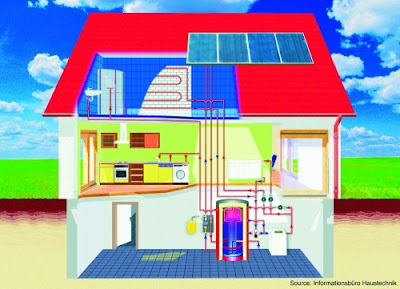Here are a few video clips which show how to take maximum advantage of the sun's light and heat using passive solar energy designs:
Friday, May 9, 2008
Passive Solar Energy Designs
Posted by Mariya at 3:48 PM 0 comments
Labels: passive solar energy
Wednesday, May 7, 2008
Active Solar Heating
Posted by Mariya at 5:44 AM 1 comments
 |
Active solar heating generates much more heat than passive systems do. Active solar heating relies strongly on three components: a solar collector to absorb the solar energy, a solar storage system, and a heat transfer system to disperse the heat to the appropriate places in your home. Liquid-based heating systems use a liquid to collect the energy in the solar collector; whereas air-based heating systems absorb the energy through the air.
Active solar technologies are used to convert solar energy into useable heat and cause air movement for ventilation or cooling.
Monday, May 5, 2008
Passive Solar Space Heating
Posted by Mariya at 12:09 PM 0 comments
 |
Direct gain is solar radiation that directly passes through the home's windows and is traped in the living space. Direct gain uses classic passive solar design strategy - the sunlight falls directly into the space and is absorbed by an abundance of thermal mass materials.
Indirect gain collects, stores, and distributes solar radiation using some thermal storage material (e.g., Trombé wall or a thermal storage wall). Conduction, radiation, or convection then transfers the energy indoors. Sunlight is absorbed by the wall, which heats up slowly during the day. Then as it cools gradually during the night, it releases its stored heat over a relatively long period of time indirectly into the space.
Isolated gain (e.g., sunspace) collect solar radiation in an area that can be selectively closed off or opened to the rest of the building. That heat than can be distributed into the living area in a variety of ways. The sunspace has the same characteristics as a direct-gain system - extensive south-facing glazing and thermal mass, and it should be well constructed, with low infiltration and high insulation levels.
In the case of passive solar space heating the whole house operates as a solar collector (passive solar home). A passive solar home is designed to let in as much sunlight as possible. It is like a big solar collector.
Sometimes for passive solar energy to be utilized effectively there must also be a means for the heated air to circulate throughout the home. Usually, the natural circulation of air is enough as long as doors are left open throughout the home, however, sometimes fans are also incorporated into the design to facilitate this.
Passive solar heating features can reduce heating bills by almost 50 percent and it requires little or no investment of external equipment. Building a passive solar home may even cost the same as building a conventional home, especially if you're working with a builder who is familiar with the processes of passive solar heating systems.
Friday, May 2, 2008
Solar Heating Systems
Posted by Mariya at 8:19 AM 0 comments
The appropriate use of windows along with building design is called passive solar heating. The buildings can be designed to make the best use of the sun in winter while keeping the heat out in summer. South-facing, large windows, building materials that absorb and retain heat (such as stones and bricks), and efficient airflow are among the design features of a home that takes advantage of passive solar.
Active solar heating systems use mechanical equipment, such as pumps and fans, to increase the usable heat in a system. The heat is primarily used for heating water in homes, commercial buildings and industrial facilities. Active solar heating can be further divaded into liquid-based and air-based systems according to the kind of energy transfer fluid that is used.
Labels: solar energy basics, solar heating systems
Thursday, May 1, 2008
Passive Solar, Active Solar and Photovoltaics
Posted by Mariya at 3:26 AM 0 comments
There are three different ways to harness the sun's energy: passive solar, using architectural design and natural materials to absorb the sun's energy; active solar, utilizing the sun's heat by means of solar collectors; and a third way in which solar energy can be harnessed is through the use of photovoltaic systems.
Passive solar is the capturing and storing the suns' energy - light and heat - without the use of any mechanical devices. As the solar radiation strikes windows, walls, floors, and other objects within the room it is converted to heat. A good example of a passive solar energy system is a greenhouse.
Active solar uses devices to collect, store, and circulate heat produced from solar energy. Active solar energy technologies convert sunlight into heat by using a particular energy transfer fluid. This is most often water or air but can also be a variety of other substances.
Photovoltaic systems directly convert sunlight into electricity using a semiconductor material such as silicon. The electrical energy from PVs can be stored in batteries for use when there is no sun (during cloudy days or at night).


